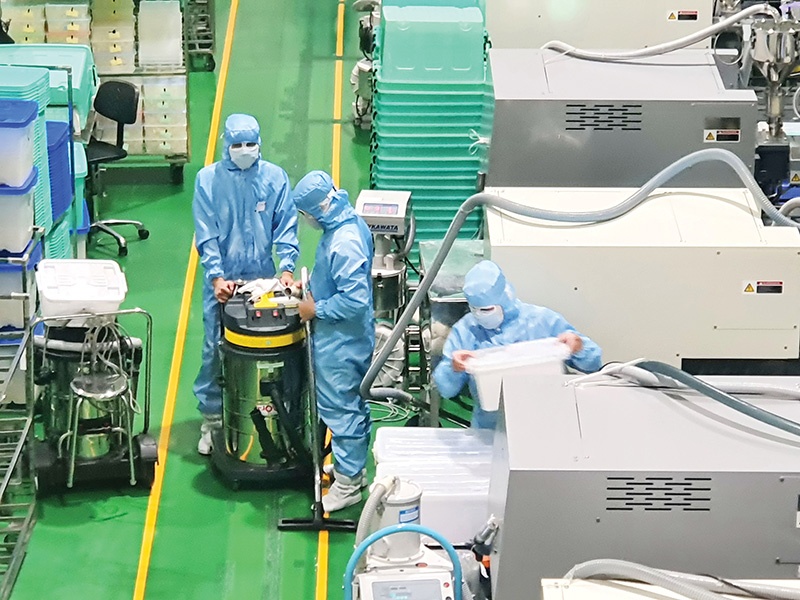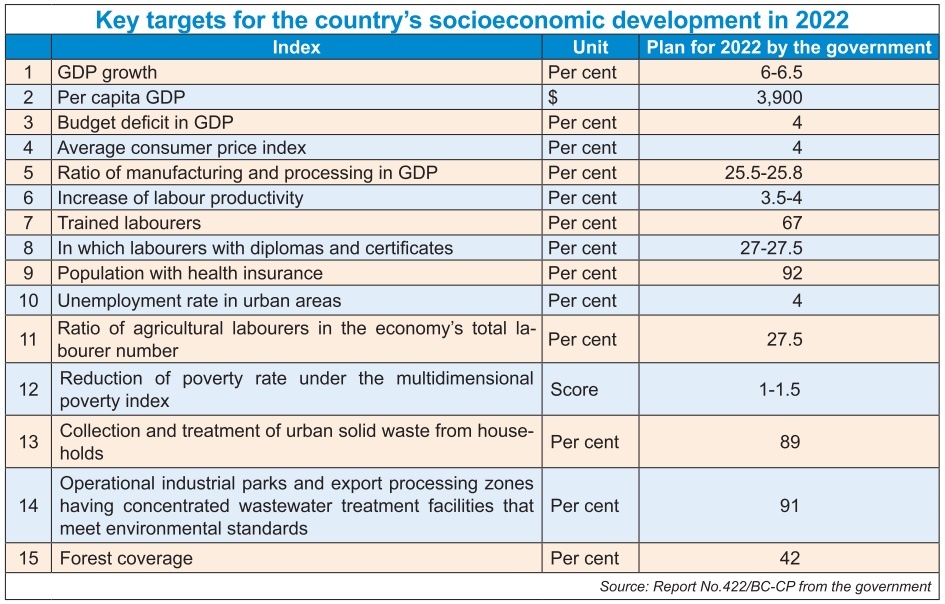Resolutions set stage for a recovery
 |
| Labour productivity increase is one of the vital goals for the year Photo: Le Toan |
Similar to the beginning of previous years in recent times, the government last week enacted two hallmark resolutions to boost economic growth and fuel the development of businesses, the very backbone of the economy.
However, the solutions in this year’s resolutions consist of many differences.
Inspired by successful large-scale vaccination coverage nationwide and strong recovery of the domestic economy and global economy, the government is looking to a brighter outlook for 2022, with an expected growth rate of 6-6.5 per cent (see box).
Prime Minister Pham Minh Chinh last week signed and enacted the government’s Resolution No.01/NQ-CP on key tasks and solutions for the deployment of the socioeconomic development plan and state budget estimates for 2022, and Resolution No.02/ND-CP on continuing the implementation of key tasks and solutions to improve the domestic business climate and enhance the national competitiveness.
Under Resolution 01, the government has identified “solidarity, discipline, proactive adaptation, and recovery and development” as guidelines for actions in 2022.
The government has defined 12 key tasks and solutions. They entail combating COVID-19; perfecting institutions and enforcing laws; boosting economic restructuring pertaining to renewal of the growth model while improving the productivity, quality, and effectiveness of the economy; infrastructure development; and development of economic zones and urban areas.
Other tasks on the list include cultural development and ensuring social equality; effective usage and management of natural resources and response to climate change; fighting against corruption; expanding international integration; and creating social consensus.
Meanwhile, under Resolution 02, the government requests ministries, municipal and provincial people’s committees, and other governmental agencies to comprehensively enforce main tasks and solutions to enhance Vietnam’s business environment and national competitiveness this year.
The government orders that priority is given to removing and amending overlapping legal documents, and continuing to reduce business conditions. In 2022, reviewing and assessing the lists of conditional business lines must be completed as this will lay a foundation for proposals for revising and supplementing relevant legal documents, meaning ministries and localities must change their mindset in treating businesses in a more friendly manner, according to the Central Institute for Economic Management (CIEM).
Notably, Resolution 02 unscored tasks and solutions for the national digital transformation programme by 2025 with a vision towards 2030. It also underlined solutions to improve the country’s preparedness for new production in the era of Industry 4.0.
According to the CIEM, the resolutions manifests the government’s constant efforts to drive the economy forward, and create a more business-friendly climate for enterprises and investors who are showing their confidence in the economy’s great potential.
Each percentage of growth can create 350,000-400,000 direct jobs and many other hundreds of thousands of indirect jobs.
 |
Great expectations
Hong Sun, vice chairman of the Korea Chamber of Business in Vietnam, told VIR that the South Korean business community welcomes not only resolutions 01 and 02 but also any other favourable policies in favour of enterprises and investors.
“This will make them operate more effectively,” Sun said. “Currently, despite many similar policies, South Korean firms are still facing many obstacles in Vietnam. For example, the licencing of some large-scale projects from South Korea in Hanoi and Ho Chi Minh City has been delayed due to a lack of clear legal guidelines, making it difficult for investors.”
However, Sun continued, “We are seeing a big climb in South Korean investment in Vietnam, where there is quite an attractive investment climate.”
During January-December 20, 2021, South Korea poured $4.95 billion into Vietnam, making itself the second-largest foreign investor, following Singapore at $10.7 billion. South Korea’s accumulative investment in Vietnam as of December 20, 2021 reached $74.65 billion, making this northeastern Asian nation the largest foreign investor in Vietnam.
A representative from the American Chamber of Commerce in Vietnam (AmCham) also hailed the resolutions.
“We know the prime minister and the government have prioritised administrative reform as a method to improve the ease of doing business. It is critical that all companies and investors encounter a fair, transparent, predictable, and streamlined regulatory environment that values innovation - not only to attract new and growing investment, but that welcomes imports,” the representative said.
For example, the representative added, the development of an innovative healthcare system and the importing of innovative medicines has been hampered by regulations. “We look forward to finding solutions to those issues going forward and working together to build up an innovative healthcare system,” he said.
According to AmCham, there are many things the government can do now to make Vietnam more attractive for foreign investment. For one, it is necessary to accelerate the use of e-government, e-commerce, e-banking, fintech, modern cloud computing, and the overall reduction of paper and cash for all businesses.
Jacques Morisset, World Bank lead economist and programme leader for Vietnam, told VIR that he expects all policies enacted by the government to be materialised as soon as possible so that enterprises can perform better and the economy can grow further qualitatively.
“I think the Vietnamese government has effectively implemented the recovery of production activities. Of course, not all workers have returned to their factories but in general, thanks to the existing policies, the economy has demonstrated its impressive recovery ability,” Morisset said. “The export and production sectors in Vietnam are now bouncing back strongly, even stronger than in 2020, and that is impressive.”
Going forward
In 2021, Vietnam’s economy grew only 2.58 per cent, the lowest level since the 1990s. However, after declining -6.02 per cent for Q3 due to the serious resurgence of COVID-19, the economy bounced back to 5.22 per cent on-year in Q4, higher than the on-year 4.61 per cent in the corresponding period last year.
The Asian Development Bank has assumed that if the coronavirus pandemic is brought under control and full vaccination covers 70 per cent of the population by the second quarter of 2022, the growth forecast for 2022 will be 6.5 per cent.
According to global analysts FocusEconomics, the Vietnamese economy is estimated to grow at the fastest rate in the region in 2022, following 2021’s projected solid expansion. Higher growth in consumer and capital spending, combined with a robust external sector, should boost activity in 2022. FocusEconomics expects GDP to expand 7.3 per cent in 2022, and 6.9 per cent in 2023.
The World Bank also released its prediction on Vietnam’s economic outlook, saying that Vietnam’s economy could expand by 6.5 to 7 per cent from 2022 onwards.
Francois Painchaud, resident representative of the International Monetary Fund in Vietnam, also told VIR, “There are signs of a tentative recovery as pandemic containment measures are lifted. The vaccinations roll out continues and households and firms adapt to life and work with the virus. The economy is forecasted to grow at 6.6 per cent in 2022 while inflation is broadly forecasted below the government targets.”
What the stars mean:
★ Poor ★ ★ Promising ★★★ Good ★★★★ Very good ★★★★★ Exceptional
Related Contents
Latest News
More News
- Vietnam's IFC to target global investment flows (December 21, 2025 | 18:00)
- Ha Tinh breaks ground on major Vingroup industrial and energy projects (December 19, 2025 | 18:24)
- EVN launches major power infrastructure projects nationwide (December 19, 2025 | 18:17)
- VAL inaugurates second production line to meet domestic animal feed demand (December 19, 2025 | 16:37)
- Sun Group pioneers urban tram system in Phu Quoc (December 19, 2025 | 15:00)
- Top 10 notable events of Vietnam’s industry and trade sector in 2025 (December 19, 2025 | 14:00)
- Seven major projects launched to drive Hanoi’s next growth phase (December 19, 2025 | 14:00)
- Rare, beautiful, sustainable: the mark of iconic real estate (December 19, 2025 | 08:00)
- Mondelez Kinh Do - a chapter of purpose-led leadership in Vietnam (December 18, 2025 | 09:44)
- VNPAY services receive the highest-level PCI DSS international security certificates for six consecutive years (December 17, 2025 | 23:47)

 Tag:
Tag:






















 Mobile Version
Mobile Version